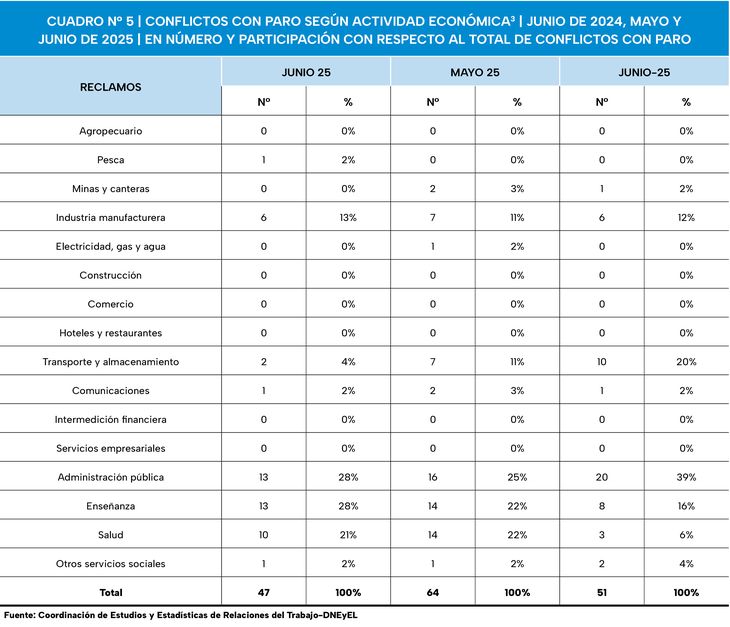During June 46 labor conflicts were recorded with unemployment, which represented a 10% decrease in relation to the same month of the previous year and 22% compared to May 2025as reported on Wednesday by the Ministry of Human Capital, through the Ministry of Labor, Employment and Social Security.
Last June, The amount of strikers (249,709) experienced a 34% and 61% setback compared to May this year. The Number of individual days not worked (338,721) behaved in the same way, registering a 28% drop compared to June 2024 and 57% compared to May 2025.
The least conflict is due to the fact that The unions no longer fight for wages and also begin to concentrate on the particular problemsthey explain in official media.
Table 2
In this sense, labor sources argue that it is observed A turn in the attitude of unions Since “before with inflation, the unions came, claimed increases and ready.” There are even some unions that believe that their struggle is to fight salary improvements but not for jobs because “unemployment is a government problem.” In fact, the guilds never raised the fight against informal work that is almost 40%.
Also the decrease in conflict responds to A more mature attitude of the three parties involved, that is, guilds, businessmen and the Statein a context in which “Dialogue is encouraged.”
In this sense, it stands out A change in the role of the Ministry of Labor and affirm that “we are not to impose, we are to arbitrate.” And they add that the fundamental slogan that encourages the Secretary of Labor is “Eradicate violence in collective conflicts.”
This means that from the Government it is promoted to the fact that “No union forces a worker to do what he does not want ”a phenomenon that also explains the decline in the amount of strikes.
By disaggregating statistics on labor conflict, it is observed that, At the state level, between June 2024 and June 2025, there was a growth in the amount of conflicts with unemployment (+6%) although with a moderate decrease in the amount of strikers (-1%) and a little more intense of the unrelated days (-15%).
On the contrary, in the same period, Labor conflict in the private sphere registered a decrease in the three indicators: number of conflicts with unemployment (-44%), strikers (-94%) and the non-worked days (-73%).
Causes of strikes
Conflicts with unemployment

As for the causes that motivated conflicts with unemployment in June 2025, the Claims for salary improvements (27 conflicts) and demands for payments owed (6 conflicts). Between June 2024 and June 2025, a growing predominance of conflicts caused by salary improvements was observed, which went from representing 49% of the total to 59%. On the contrary, conflicts linked to dismissals decreased both at the absolute level (from 9 to 3) and in relative terms (from 18% to 7%).
When considering the activity sectors, it was observed that last month89% of conflicts with unemployment were recorded in public administration (13), teaching (13), health (10), and the manufacturing industry (6). Between June 2024 and June 2025, the Public Administrationalthough with absolute and relative participation in decrease (from 39% it went to 28%), The activity continues with the highest level of conflict.
During June 2025, The largest amount of conflicts occurred in the provinces of Buenos Aires (10), Entre Ríos (4), Jujuy (4) and Santa Cruz (4).
Regarding the Labor conflict without unemploymentin June 2025, 117 conflicts were recorded, representing an increase of 48% compared to June 2024, and remained constant in relation to May of this year. The mostly deployed actions were: the concentration (43), followed by the Organizational Declaration (21) and the mobilization (23).
Finally, in terms of the main reason that originated the unpaid conflicts in June 2025, they found themselves: Salary improvements (45), followed by the dismissals or non -contractual renewal (23), the payments owed (19) and other claims (17) where those demands in rejection of government policies were recorded.
Workers’ concern
As for the perspectives, the unions are transferred to the authorities their concern for him Impact of imports On the activity of local businesses, particularly SMEs that are the ones that cost them most to compete.
As for the public sector, in union media it is considered that The dismissals in the state will continue and a new factor of concern is the progress of the privatizations that could lead to a reduction in the payroll of workers.
Source: Ambito




